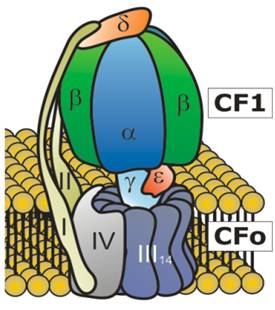ROS impact on CF1CFo
Plants have to cope with the fact that varying light intensities during the day only by chance correlate with other factors ensuring optimal photosynthesis. As a consequence, highly reactive intermediates together with high levels of oxygen lead to a rapidly changing amount of intracellular reactive oxygen species (ROS), in particular singlet oxygen, which have a strong damaging impact on the whole photosynthetic machinery. Although during evolution plants developed various mechanisms to scavenge all types of ROS efficiently, sometimes high light stress can overcome these lines of defence, resulting in a significant damage of the photosynthetic machinery. Up to now, the impact of singlet oxygen was almost exclusively related to damage within close vicinity to photosystem II (PS II) due to the fact that this oxygen form was reported to have an extreme short half life. However, recent finding suggest that singlet oxygen might be more stable in vivo than previously anticipated.

Aim of this project is to understand the impact of singlet oxygen on the CF1CFo machinery on the molecular level and to find out, if there is any link between this effect and the quantity of ΔpH mediated non photochemical quenching, which would shed new insight in the molecular response mechanisms of intra organelle protection against high light stress. We took advantage of the fluorescent (flu) mutant of Arabidopsis to analyze the impact of singlet oxygen on chloroplast proteins in a non-invasive manner. flu-mutants accumulate high amounts of protochloro phyllide in the dark, which subsequently acts as a strong photosensitizer upon illumination. In cooperation with Klaus Apel’s group in Zurich/Cornell we analyzed the in vivo impact of singlet oxygen on thylakoid proteins in flu. Hence we could show that already after a few minutes a ROS induced modification of the thylakoid ATP-synthase complex (CF1CFo) in particular the γ subunit could be detected.
Singlet oxygen as well as hydrogen peroxide specific aberration became evident after analyzing the thylakoid protein pattern via 2D-PAGE and subsequent MALDI MS. Using an in vitro assembled CF1Cfo we could show that exposure of thylakoids to ROS results in specific oxidation of a defined amino acid cluster within the γ subunit. This modification affects ATP hydrolysis as well as ATP-driven proton translocation.
